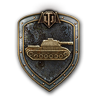
On September 8th 1941, the German Army received the order to capture the city of Leningrad (now known by its original name of Saint Petersburg). This operation was supposed to take only a few days to complete. However, due to the tenaciousness of the resisting inhabitants, the siege ended up lasting for 900 days – two and a half years, despite the lack of resources and food for the resistance. This weekend, we celebrate the end of the blockade in January 1943, highlighting some tanks present at this time.
From the January 19th at 07:00 CET (06:00 GMT) until January 22nd at 06:30 CET (05:30 GMT), you can enjoy the following bonuses in game:
Crew experience x2
Make your soldiers learn faster during this special.
 7000 credits earned with the Steel Wall medal.
7000 credits earned with the Steel Wall medal.
Be strong and roll with the punches! This medal is awarded to those tankers who receive and survive more hits (at least 11) with a potential damage of at least 1,000 HP than any other player on the entire battlefield.
50% discount on the following tanks:
 Tier VI KV-1S (Soviet)
Tier VI KV-1S (Soviet) Tier V PzKpfw IV (German)
Tier V PzKpfw IV (German) Tier III SU-76 (Soviet)
Tier III SU-76 (Soviet) Tier V StuG III (German)
Tier V StuG III (German)
How about enlarging your arsenal for half price?
70% more credits with the following tanks:
 Tier VI KV-1S (Soviet)
Tier VI KV-1S (Soviet) Tier V PzKpfw IV (German)
Tier V PzKpfw IV (German) Tier III SU-76 (Soviet)
Tier III SU-76 (Soviet) Tier V StuG III (German)
Tier V StuG III (German)
Not only are they cheaper, you win also more credits after each battle!
25% discount on camouflage
Choose a temporary or a permanent new look for your favourite vehicles!
Remember that this special is only available until Tuesday, so don’t miss it!
Less than two and a half months after the Soviet Union was attacked by Nazi Germany, German troops were already approaching Leningrad. The Red Army was outflanked, and on September 8th 1941, the Germans had fully encircled the city. Inside the walls were a strong garrison and around 3 million civilians. All refused to surrender, and a bitter and long siege began.
At the beginning of the siege, it was estimated that there were food and fuel stocks for no more than two months. During the winter of 1941-42, there was no heating, no water supply, almost no electricity and very little food. In January 1942, the winter was unusually cold, and the city's food rations reached an all-time low of only 125 grams of bread per person per day. During January and February of 1942, 200,000 people died of cold and starvation in Leningrad. Despite these tragic losses and the inhuman conditions, the city's war industries still continued to work and the city did not surrender.
The German troops tried to encourage the city’s occupants to surrender, sending out leaflets saying “Join our troops and we will give you food!”, but Leningrad’s soldiers resisted.
After January 1942, the daily rations increased a little, mainly due to two different factors – the decrease in population over the winter, and a supply route via the Ladoga Lake beginning to function. This supply route, called the “Road of Life”, made it possible to evacuate some of the civilians. However, the conditions were bad and the road was attacked by German air strikes. The “Road of Life” was also the “Road of Death”.
In January 1943, a counterattack under the codename of Operation Iskra (Spark) managed to open a breach in the German blockade. The corridor was wide enough to allow the construction of a railway, and vastly improved the supply situation of the city, where by now only soldiers and able men stayed to defend. Nonetheless, the city remained under heavy shelling and, it took over one year before the siege was finally broken on January 27th 1944. The corridor gained in Operation Iskra proved to be the breaking point.
From the beginning to its end, the siege lasted for two years, four months, two weeks and five days. It is estimated that 641,000 civilians died in the besieged city, and more during the evacuation. The city was heavily damaged by fighting. However, the siege tied up vast Axis resources and as a result, this helped to slow down the Axis advance and to protect one of the “lifelines” of USSR, the northern seaports.
